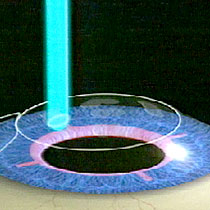2007年VOA标准英语-State of the Art Technology Improves Vision for(在线收听)
Washington
03 September 2007
U.S. Military doctors have performed more than 100,000 eye surgeries on active duty personnel to eliminate the need for glasses or contact lenses. Now, at the new Joint Warfighter Refractive Surgery Center, they expect to perform even more. VOA 's Carol Pearson has more on the technology and how it impacts troop performance.
The Joint Warfighter Refractive Surgery Center opened just recently in the southwestern state of Texas. It uses state of the art technology not available anywhere else in the U.S. Personnel from all branches of the U.S. military will have their vision corrected there.
 |
| laser procedure |
"If you have to wear contacts or glasses, you can't wear night vision goggles, you can't be out in the desert environment, you can't be out in the mountains of Afghanistan. Your eyes are getting dry. So refractive surgery is the answer for that."
Navy ophthalmologist Doctor Steve Shallhorn started providing refractive surgery to active duty personnel in 1993. "It gives them an edge. It gives them a big edge. It improves their effectiveness as war fighters and also their survivability."
Navy Lieutenant Laura Reeves is a helicopter pilot who used to depend on contact lenses until she had refractive surgery. When she was interviewed in 2006, she said refractive surgery improved her ability to do her job."As far as flying goes, when we go into the dirt and do turf landings, I don't have to worry about gravel or sand flying up into my eyes, where, when I had contacts, I would constantly have to rub them and remove any filaments.
As for risk, Dr. Reilly says every surgery carries some risk, but he says the new technology and meticulous pre-operative evaluations minimize the risk.